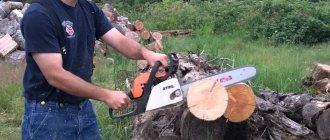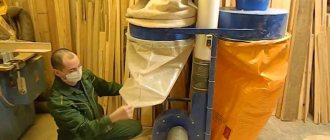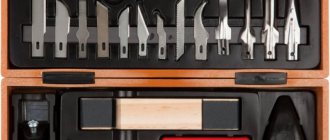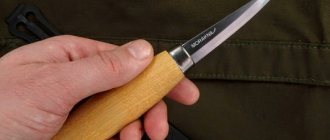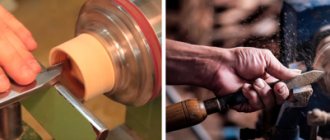One of the most pressing topics for any carver is where to get a good wood tool? High-quality, well-sharpened wood cutters can help out even a less experienced craftsman. The cuts are smooth, clean, and working with such a tool is much easier! Having tried different options for the source material for making woodworking tools, from scalpels to razors, I settled on metal cutters.
They are quite fragile and strong at the same time. Carbon steel allows you to keep the edge of the blade sharp for a long time; it does not dull even on hard wood. So, first we cut the cutter on a metal cutter according to a pre-applied drawing of the future cutter.
In our case, this is a small cutter knife, which is the main tool of the carver.
The presence of such an abundance of sparks during cutting indicates that the steel is good, carbon, and therefore suitable for wood carving.
It turns out to be such a preparation.
It is desirable that the part that will be in the handle be larger than the blade. This is for durability. We polish the knife blade, constantly dipping it in cold water to prevent it from overheating.
Now you need to make a handle for the knife. To do this, we take slats made of durable wood. In one part we draw the outline of the knife, the other as an overlay.
We cut a hole in the wood in the shape of a knife so that it is flush, coat both parts with PVA glue.
We glue the knife in a vice. Gluing takes about 12 hours or a day.
After gluing, we sand the handle and sharpen the knife to the desired sharpness. Using this principle, you can make a knife with your own hands. By the way, excellent wood chisels are made from metal drills.
And semicircular chisels made from punches.
A knife-jamb can be made from a rapite saw.
Here are some more wood cutters that I made with my own hands from a metal cutter.
- Related Posts
- Wood Miter Table Saw
- Tabletop sharpening machine. Application possibilities
- How to make a carpentry workbench with your own hands
« Previous entry
Purpose of the chisel
A semicircular chisel should be used to create recesses for artistic carving. Using the tool, you can make convex or concave serifs.
The wood carving tool consists of 2 parts. The handle is most often made of tough wood: maple, elm, hornbeam, ash. There are plastic options; for ease of use they have rubber inserts.
The main part of a semicircular chisel is a metal cutter, sharpened on one side, usually at an angle of 250. It is made of alloy steel, due to which precise elements are formed on the material. Requirements according to GOST allow the use of metal grades HVG, 9ХС and 9ХФ.
GOST 1184-80 Flat and semicircular chisels
1 file 494.99 KB
Depending on the degree of rounding, the metal part can be sloping, round or semicircular. The larger the diameter of the blade, the smoother the cut will be when working on wood.
On both sides of the handle (at the end and at the junction with the cutter) you can usually see a metal ring. It prevents damage to the wood when struck with a chisel.
Manufacturing and service
Making the cutter yourself
Many craftsmen, either wanting to save money or not trusting third-party manufacturers, prefer to use homemade carving tools. In principle, making a knife or chisel is quite simple, the main thing is to choose the right material.
The photo shows a hacksaw blade and a simple jamb knife made from it
The raw materials for our design can be used:
- A saw blade for wood or metal is an almost ideal blank for a jamb knife. During the manufacturing process, we cut off a piece of blade on a machine or simply break it off at the angle we need, and then form a cutting edge.
- The wood saw blade also has acceptable characteristics. The carbon steel used to produce such saws holds an edge well, which means that the cutter will not become dull even when working with hard wood.
- Before making a semicircular chisel, you can look “in the bins” for an unnecessary punch. To make a tool, we will only need to cut off part of the wall diagonally - and we will get a very convenient device for sampling wood.
An important part of any cutter is the handle.
The instructions for its manufacture are also not complicated:
- We take a block of hardwood and cut a handle out of it.
- We make a hole at the end of the handle, the shape of which corresponds to the shape of the shank of the metal part.
Gluing the blade into the handle
- We glue the cutting part into the handle, and then clamp the structure with a metal ring.
Note! Sometimes the handle is made of two halves. In this case, the blade can be additionally secured with screws or rivets, and gluing should be done in a vice or clamps.
Sharpening cutters
You can only get a decent result if you work with a perfectly sharp tool. And since even the softest wood dulls the blade quite quickly, sharpening wood cutters is definitely included in the “minimum program” of training for a novice carver.
To perform this operation we will need:
- Bars of different grain sizes - from coarse to fine.
- Old leather belt for straightening.
- GOI paste (or similar composition).
We do the work like this:
- First, we moisten a coarse-grained block, place the cutter on it at the selected angle and sharpen it using pressure from ourselves.
- We switch to a block with medium abrasive grain and repeat the operations until a clearly defined sharpened edge appears.
- We carry out the finishing on a diamond stone, removing the metal chamfer that appears on the tip of the cutter.
- Then we apply a layer of GOI paste (a composition based on chromium oxide) to the belt and polish the working part to a mirror shine.
Editing on the belt
Advice! Finishing on the belt can be done more often than the main sharpening - this way we can correct a slightly dull blade.
It’s easy to check the quality of our work: if the cutter cuts the newspaper without effort, it means we’ve done everything correctly, and we can start working on the workpiece.
Tool classification
The product classification is based on several parameters:
- blade size;
- method of making a cutter;
- degree of rounding.
The standard length of a semicircular or straight tool with a handle is 125-290 mm, of this parameter the blade dimensions are 110-145 mm. The width of the metal part is 4-50 mm.
Significant parameters of the blade of a semicircular chisel are width and depth. The ratio of these values can be different, which determines the depth of the formed recess when processing the workpiece.
The metal part of the chisel can be made by stamping, forging or punching. The first type of blade has average hardness and strength. Forged fabric is used when the requirements for strength are increased. Cutting steel allows for precise cutting of soft wood. The blade obtained in this way is inferior to others in strength and hardness.
Semicircular chisels are classified by numbers (No. 1, 2, 5, 6). If you place the tool vertically and mark the notch, the diameter of the resulting semicircle (in cm) corresponds to the number.
How to choose
Advice on choosing a chisel can be given after determining the purpose for which it will be used. A carpenter should have samples of different sizes and shapes in his arsenal.
Carving chisels with a straight blade are considered universal. It is used for finishing the workpiece. A round cutter is used to form an indentation on the board.
The corner chisel forms V-shaped elements and is therefore used for geometric wood carving. Using a semicircular tool, it is best to create ornaments of varying degrees of complexity. A variety of this species is cranberry, which allows the formation of a deep furrow.
When choosing, it is important to pay attention to the quality of the steel. An inscription confirming the metal class (drop forged, CrV) must be applied to the surface of the blade. They confirm the composition of the steel, which should consist of chromium and vanadium. In addition to these designations, the manufacturer of the cutter must be indicated. A quality tool cannot be cheap.
You can check the quality of steel on a grindstone. When processing high-quality material, burrs appear on the tip, which can be easily removed using a medium-fine sandpaper fraction.
How to do it yourself
To make a semicircular chisel for wood carving, an old metal milling cutter is best suited, since the material meets the strength requirements. The presence of a tooth on the saw allows you to designate a protrusion where the handle area begins. Using metal scissors, cut out a strip of the required width and length.
In the middle of the intended blade, a groove is formed using a rod 4-5 mm wide. The outer contour of the cutter is drawn out on an emery machine.
Next, a handle is made for the semicircular model used to work with the ornament. To do this, a hole is made in the block where the base is placed. The steel part is fixed in the workpiece using epoxy resin.
Using a saw and plane, the handle is given the desired shape and size. Next, the surfaces are sanded to make them smooth.
Attachments and accessories for sanding wood
Discussion: 31 comments
- Matvey:
10/09/2011 at 11:57 amVery clear and understandable!!! THANKS A LOT!!! and then they say... he took it and did it, but here everything is clear.... I wish I could tell you more about making a pen...
Answer
admin:
10/10/2011 at 10:58 am
Good wood cutters also require a good handle. See how to refine and polish them in another section.
Answer
10/10/2011 at 11:02 am
Section: wood processing, post attachments and sanding devices.
Answer
- Andrey:
08/13/2014 at 12:42 pm
Good afternoon ! Try to release the metal, (an old recedevist told me this) put metal into a plugged pipe at one end (from which we will make a knife) and fill it with sand, jam the pipe from the other end. Then we put it in the oven, this device should cool in the pipe. After this we cut the pipe. Metal will not crumble and will not be so brittle
Answer
10/18/2011 at 6:56 pm
I would like to buy this cutter that you made from a metal cutter. Would you sell this cutter?
Answer
12/22/2011 at 1:38 pm
funny information. A cutter from a milling cutter, a chisel from a punch, a cranberry, for example, from an old crankshaft......Well, firstly, cutters are not made of carbon steel at all. This is high-alloy steel of the R6M5 type. With carbon steel, hammers and files. The hardness of the cutter is 60HRC and it will not make a normal cutter. If you do normal sharpening, the cutting edge will constantly chip, and this is not a thread, but fidgeting. Proper heat treatment of high-speed steels such as R6M5, R18, etc. Not every blacksmith can do this. And the product will either turn out to be a good miniature cleaver, or a headache and calloused hands. In world practice, only turning wood cutters are made from high-speed steel, and even then in Japan. They weld a cutting edge 10 millimeters wide and that’s it. Alas, it’s an axiom that for normal incisors, normal iron…..With great respect for the homemade ones. Alexander Korneev.
Answer
- admin:
12/23/2011 at 5:44 pm
Thank you for your comment Alexander! But unfortunately or fortunately, I don’t know the markings of the cutters, I just take it and try it. By the way, this idea was given to me by professional cabinetmakers and I trust their experience because they work every day. But there is some truth in your words, really, You shouldn’t make cranberries from a crankshaft. And thank you again for the detailed information, since it also has a basis and experience.
Answer
01/30/2013 at 8:44 am
Alexander, are you a professional carver or are you just spinning around this topic. I have been working as a carver for 16 years, 10 of them professionally. I made all the tools for myself from metal cutters, this is an ideal steel for chisels. And when I read about what the cutter doesn’t fit, then I see first of all an amateur (sorry if I’m wrong).
Answer
12/25/2011 at 9:41 am
A huge hello to fans of R6M5 and other heat-resistant steels. The only advantage of this iron is the ability to make a cutter at home without heat treatment. For some it is out of poverty, for others out of greed, the third director is his own. It also happens from communicating with Tatyanka girls. I’m far from an amateur, I’ve been making cutters for over 30 years, I’ve tried a lot of steels, including. all kinds of exotics. And I came to the conclusion long ago that nothing better has been invented than the steels originally created for woodworking. Competent heat treatment according to the requirements. parameters and in the hands of a tool with a capital letter. But you will agree that heat-resistant steel is for metal processing and you won’t see a sharpening angle of less than 45 degrees on any product. It’s durable, but alas, it’s fragile. And this defect cannot be treated at home. However, not only .. Have you ever seen a branded wood cutter made of similar steel. Or a hunting knife or any serious one. Alas... But the bourgeoisie is not almost more stupid than us, even with his eternal thirst for profit. To Caesar is what is Caesar’s, and to Korneev what is rooted to Korneev. Sorry for the pun, time to get to work.
Answer
- admin:
12/25/2011 at 1:16 pm
Well then, bring it to the point. Where are such tools sold, how much do they cost and what markings are there to recognize. If something is prohibited, then something must appear in return, otherwise stupor. I’m waiting for an answer. With deep respect to all masters!
Answer
11/12/2020 at 12:06 pm
But what about Adolfa Yuryev and the STRY company? They make cutters from P6M5 and P18 and their products are quite good.
Answer
12/26/2011 at 4:26 am
Hello everyone. My instrument is for sale at Vernissage from Victor Kuznetsov. You can also buy it in the Wood Carving online store. You can also order directly from the manufacturer. I live and work in the Khabarovsk Territory. So if you want to call, don’t wake me up at night. It’s a seven-hour difference from Moscow. So call, write, draw. Price from 200 rubles. and up to 500. These are chisels for park and ice sculpture and other manifestations of gigantism. Ordinary incisors, incl. turning 200 350 per unit. A set of 16 cutters costs 3 tr. There will be no show-offs like Tatyanka or a stayer. Just normal cutters made from quality metal. My email address My phone number is 89622284274.
Answer
07/26/2012 at 10:38 am
Still, the author used a cutter made of carbon steel or 12ХНЗ. As you can see in one of the photos, when cutting metal, the sparks are dense and yellow. How did Alexander not notice this, who, in his words: “I’m far from an amateur, I’ve been making cutters for more than 30 years, I’ve tried a lot of steels, including. all kinds of exoticism,” it’s not clear. Steel R18—dark crimson sparks with a yellow-red tuft at the beginning, small branches at the ends of two or three threads, with light yellow grains at the ends of the tuft. At the beginning of the spark there is a bright red beam from the touch of the workpiece to the abrasive wheel. (R6M5 also never gave yellow sparks during processing) Such messages strongly remind me of advertising. And the arrogantly boorish tone of Alexander’s messages is not clear to me at all. I hope these messages will not discourage people reading this topic from making their own instruments. Regarding the fragility of the quick cutter, this is completely nonsense. Here are its (P18) characteristics: Steel has a reduced tendency to overheat during hardening, good VISCOSITY, good wear resistance, increased grindability. This is not a file from U8-U10A! For example, Gusarchuk D.M. (a master of artistic three-dimensional wood carving), writes in his book that his best tool is made from a quick cutter. And one more thing: steel ALWAYS has a brand (name), there are GOST standards (for example GOST 5632-72), but for some reason I have never seen “steels originally created for woodworking” anywhere... For reference: in the USSR, good chisels were produced in Leningrad, from U10A steel, but R6M5, R18 and the like were not used because of their high cost and complexity of processing. Actually, this is why the zealous Japanese “Weld a cutting edge 10 millimeters wide and that’s it”... All the data described above is taken from reference literature on metalworking, so if you wish, you can read it all yourself. And the article is very good and useful!
Answer
- admin:
07/27/2012 at 8:58 am
I address you with GREAT gratitude, Nikolai! I didn’t have enough arguments to answer that master, and I don’t think I should. Maybe he understands something, in any case, I also looked for it at one time and share my skills with people. Good luck to you!
Answer
07/30/2012 at 10:09 pm
Good afternoon, thanks for the excellent site, will you tell me if using a metal cutter does not “burn” for cooking? Please tell us in more detail about how not to burn the metal at the stage of shaping it.
Answer
- Nikolay:
08/02/2012 at 11:51 am
If you are sure that you have a workpiece made of P18 in your hands, you should take into account its remarkable features: when heated to ~600*C (dark red glow), this steel retains its properties. If the workpiece is made of U8-U10 (an old file, for example), then in order not to burn the workpiece: 1) Reduce the speed of the sharpening stone + keep a jar of water near the sharpener, where we cool the workpiece as often as possible. We do the final finishing of the chamfers on a coarse-grained block. The block must have a soft binder and be coarse-grained. 2) If possible, use a water sharpener (this is one that has a very low speed and the lower part of the stone is in the water). It is especially easy to burn the tip of a knife, so when sharpening the tip, reduce the pressure on the workpiece and often cool it in water.
Answer
admin:
08/03/2012 at 10:12 am
You need to know all these nuances so as not to spoil the instrument. If possible, we tell people. And I thank knowledgeable people who do not hide their practical skills. I advise beginners to read these tips, they are very valuable!
Answer
08/03/2012 at 2:52 pm
When cutting a workpiece with a grinder, in order not to burn the workpiece, I do not cut the workpiece with an abrasive wheel, but with light pressure I gradually select the metal along the contour previously drawn on the workpiece. If the grinder has a speed control, reduce the speed of the cutting wheel. So, without haste, you get a workpiece of the shape you need and do not “burn” its edges. To make a tool, it is good to take old, still Soviet, metal saws (for a mechanical saw), broken drills (by selecting a semicircle in the shank with an angle grinder, you get a semicircular chisel. Only drills made from a quick cutter will not work - the shank of the drill is not hardened, and a quick cutter can only be properly hardened an experienced thermal operator.), Old taps are almost ready-made semicircular chisels - you just need to sharpen them on a grindstone, the bearing race is a spoon cutter (it is advisable to choose a race with the letter U in the marking), etc. I recommend the Soviet instrument because in those days GOST standards were strictly adhered to. Now a sheet of metal of the same brand can have different Rockwell hardness in different places.
Answer
07/31/2012 at 4:15 pm
Good afternoon everyone! A set of 16 incisors from Alexander recently costs 4,800 rubles (this is about “some from greed, and some from poverty), and the manner of comments is most likely from upbringing and ethical standards, or maybe from the beginnings of “stardom”. I wish you success and “humanity”
Answer
08/04/2012 at 12:11 pm
Cutters and chisels. For cutters, I also tried many steels and also came to the conclusion that the best steel of the available options is metal cutters. I also tried high-speed steel R-18, a very good edge when cutting, but you can’t lean on it - it chips. For impact loads at a flea market I bought Soviet chisels made of high-alloy steel - 9 HF and 9 HS, scraped spoons out of them with an emery grinder, and did this in winter, in severe frosts, so that the steel would not turn blue, (natural cooling, although moisturized) in the garage, polished with flap drums clamped into a pneumatic drill. In wooden planes I also found knives with the steel marking 9 hf, used for small cutters, successfully. Good results with medical steel - a surgical instrument, perfectly withstands shock loads.
Answer
- admin:
08/04/2012 at 8:09 am
I very much agree with you on many aspects. I also tried a lot of different options, but mostly acted blindly, without knowledge of steel markings. Thank you for the addition!
Answer
08/27/2012 at 2:07 pm
Everything is great, of course, but it’s too labor-intensive, I found a simpler solution. I may not be the discoverer, but that's the idea. The task is to purchase (approximate cost 50 rubles) a feather drill (the range of sizes in width is large from 10, etc.) and sharpen it for a jamb. The steel is decent and there is no need to be tricky. I tried it in geometry, which is in no way inferior to the material from a hacksaw and a circular disk.
Answer
01/10/2013 at 5:10 pm
Yes, I use quick cutters, but not impact ones, I’m very pleased. U10 and U12 steel is good for wood. requires hardening after processing. rough sharpening anneals it. good luck to you
Answer
02/25/2013 at 10:10 am
I rarely do carving and, so to speak, “amateurishly,” but I still have knives from the milling cutter from 1999. The teacher made these knives for us at the Criminal Procedure Code after weeks of testing purchased knives. Of course, I have never used a professional tool, but 14 years for knives (even if not used so often) is a pretty decent time. The knives, of course, have already become sharpened from finishing with the “zero” (that’s why I came to this topic), but they still cope with their job quite successfully. So the topic is quite relevant, in particular for me, since only Chinese “crafts” can be found on sale here, and I don’t want to order “somewhere out there” - I need to feel the instrument before buying. In addition, the experience of using cutter knives is quite satisfactory.
Answer
- admin:
02/25/2013 at 5:53 pm
Today I work, one might say more, with jewelry carvings, where everyone is not only mm. but the micron also matters. And all the tools that I have posted on the site have been helping me with this for several years now. But as you noticed, not everyone believes in this, they say you can’t use cutters for metal as much as possible; they have to cut metal. But that’s the way my character is structured, it’s not that I’m against it, but until I check it myself, I won’t believe it. And I'm happy with the quality. I repeat once again that this is not the first year I have been doing this. I agree there are better options, but so far I’m quite happy with tools made from metal cutters. And here many practitioners support me.
Answer
09/15/2013 at 7:02 pm
I haven’t tried making cutters from a metal cutter, but I think the metal is quite suitable. He made his homemade cutters and chisels from the planer knives of a woodworking machine. They are dumb, of course; you have to constantly sharpen them, but well-sharpened and polished ones cut wood very well. I also liked the steel from an ordinary kitchen knife, which was made in Germany. Great stuff! For several years I have been using a cutter made from its fragment and I am amazed at the real German quality. )))
Answer
03.12.2013 at 12:00 pm
It doesn’t say anything about the handle of the cutter, since each cutter makes it himself according to his own hand!!!
Answer
08/08/2015 at 6:05 am
I don’t do carving myself. My uncle is a woodcarver, since the days of the USSR. Almost all the tools are homemade. Files, needle files, saws from woodworking machines, bearings, old chisels, etc. In his opinion, bearings are the most interesting material for making carving tools .The fine structure cuts perfectly, holds an edge for a long time. My experience; I made a chisel knife myself (steel 8Х6НФТ, a jointer knife) based on the Swedish Bahko knife, the sharpening angle of the chisel is 20 degrees. The sharpening angle of the chisel is 20 degrees. The knife is 40 degrees. They complement each other in removing layers of wood. It works perfectly: knife-chisel-chisel. Made from U8A carbon ( LMZ chisels) are very good. (There are about a dozen) The viscosity is pleasant and holds an edge. A quick cutter on wood works worse (I have a knife on a joint made from a mechanical saw) I bought a couple of cutters from HSS and P6AM5. I need to try to make chisels with them.
Answer
11/07/2015 at 8:45 pm
Good afternoon everyone. Personally, for the occasion, I made cutters from knives from a printing machine that cuts paper. True, the thickness is decent, it takes a long time to cut, but the result is excellent.
Answer
12/30/2015 at 12:04 am
please tell me the HSS circular saw is suitable for making cutters since I am in Italy, the steel markings are different there and it is not possible to look for a suitable material
Answer
- Sergey:
02/11/2019 at 3:19 pm
Yes, you can make cutters from HSS steel. I made a metal cutter from P18, a lot of cutters. Sharpening is hard, grinding is easy. The steel is tough, but the knives do not become dull for a long time.
Answer
Rules for sharpening chisels
The chisel needs to be sharpened at least 2 times a year. During use, irregularities and burrs appear on the metal. To sharpen the blade, use a special stone. They start working with the coarse-grained part, and as they sharpen they move on to fine sandpaper, which polishes the steel.
Semicircular and other types of tools are sharpened on the flat side. The chisel is held with both hands, slowly moving across the stone from top to bottom. As you sharpen, grooves appear on the grinding wheel. This means it's time to move to a medium-grain surface. A properly sharpened blade should have a mirror-like surface.
Knives
When working with wood, you cannot do without a good knife; when choosing this tool, you should give preference to the one that will be most convenient for processing wood. It is also important to find out what grade of steel was used in its manufacture.
When choosing a knife from a foreign manufacturer, you need to compare the specified steel grade with a domestic analogue, and check what properties it has according to the steel grade.
A good knife is characterized by a high carbon content with the addition of alloying elements.
Knives for working with wood are divided into three types: folding, with a replaceable and fixed blade. A blade with a length of 40 to 50 mm and a thickness of 4 mm is considered optimal.
Rules for working with a chisel
Before you start using a semicircular chisel, you need to learn the basics of work. To achieve the desired result, the tip is leaned against the wood, using a mallet (a special hammer), you need to tap the handle until a groove of the desired depth is obtained.
Before performing complex work, you need to practice performing different types of elements on a rough canvas. The precision of the movements and the strength of the application must be measured, since it will be difficult to correct the situation. First, you need to apply a sketch to the workpiece according to which the work with a chisel will take place.
When working, you should not remove a large amount of material at once, working in layers. Using the tool, you can cut the fabric along the fibers, cut grooves or make perpendicular notches. The last method involves applying the greatest effort.
A semicircular chisel is useful when working on wood, when you plan to reproduce a pattern or ornament on the surface. Wood carving is an art that requires skill. To create a quality product, you need to have tools of different diameters and degrees of rounding on hand. When choosing, it is worth checking the quality of the steel and compliance with the markings. A high-quality set that meets the strength requirements cannot be cheap, which must be taken into account when choosing.



